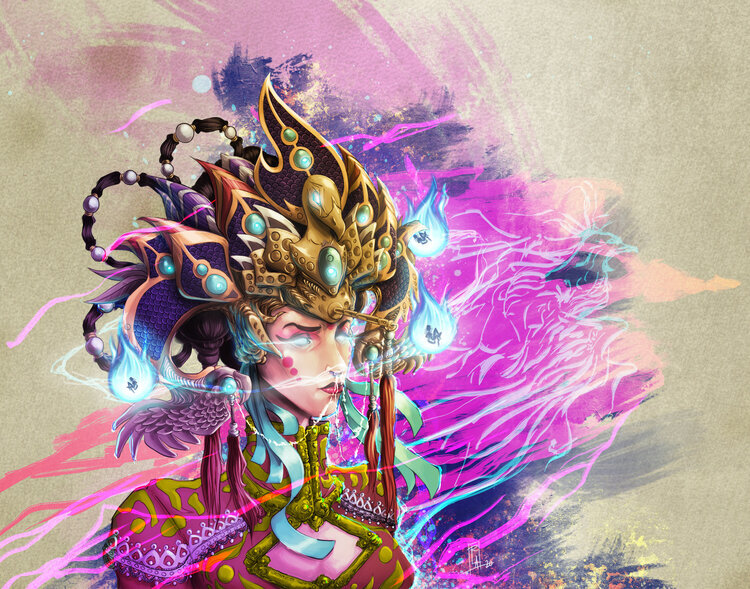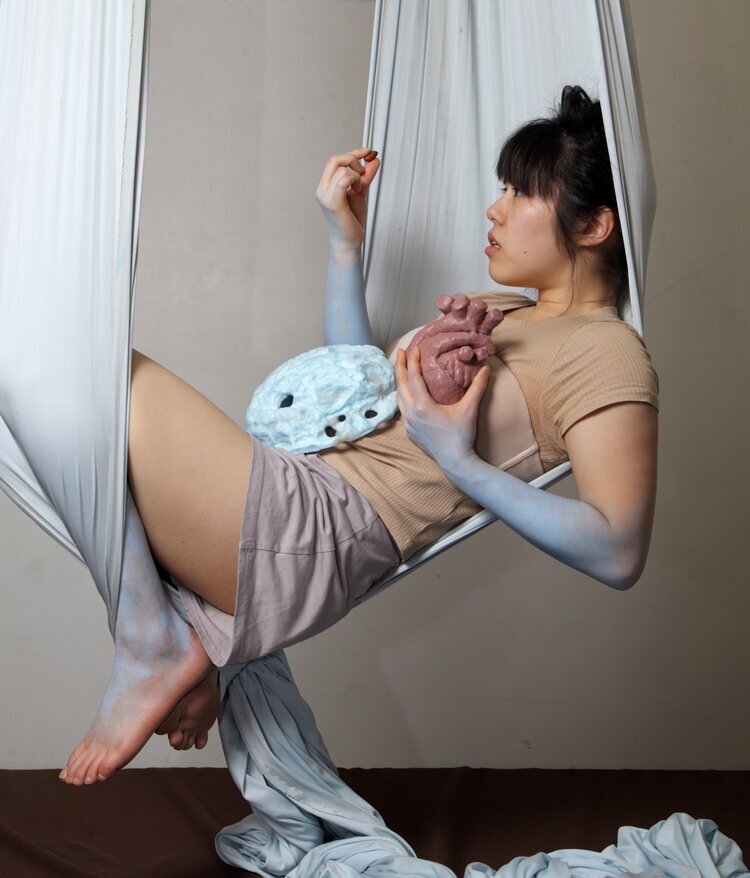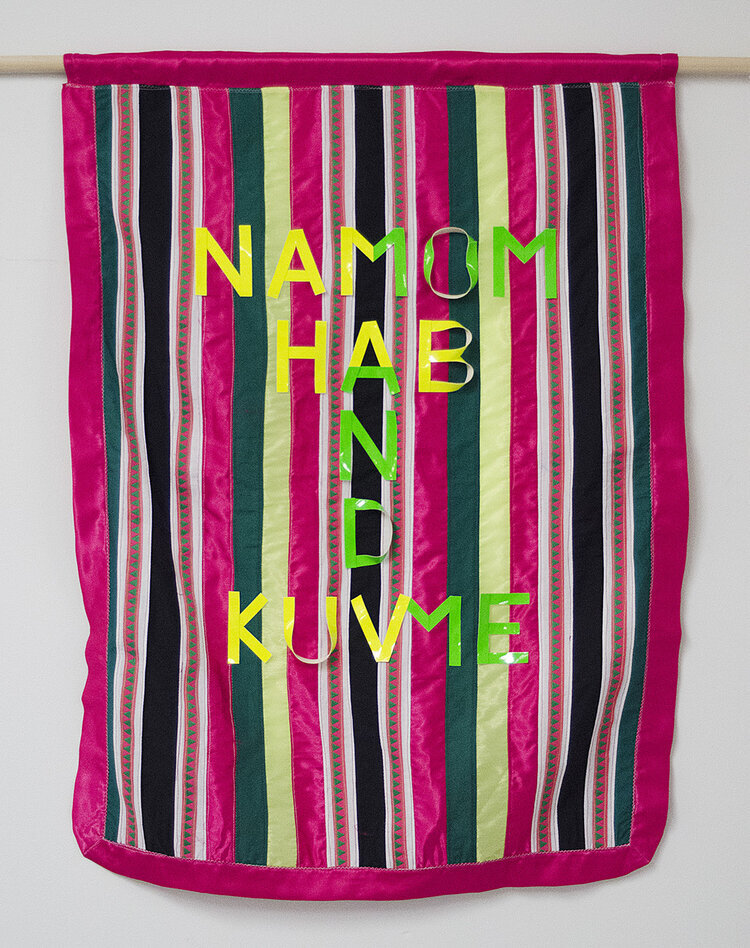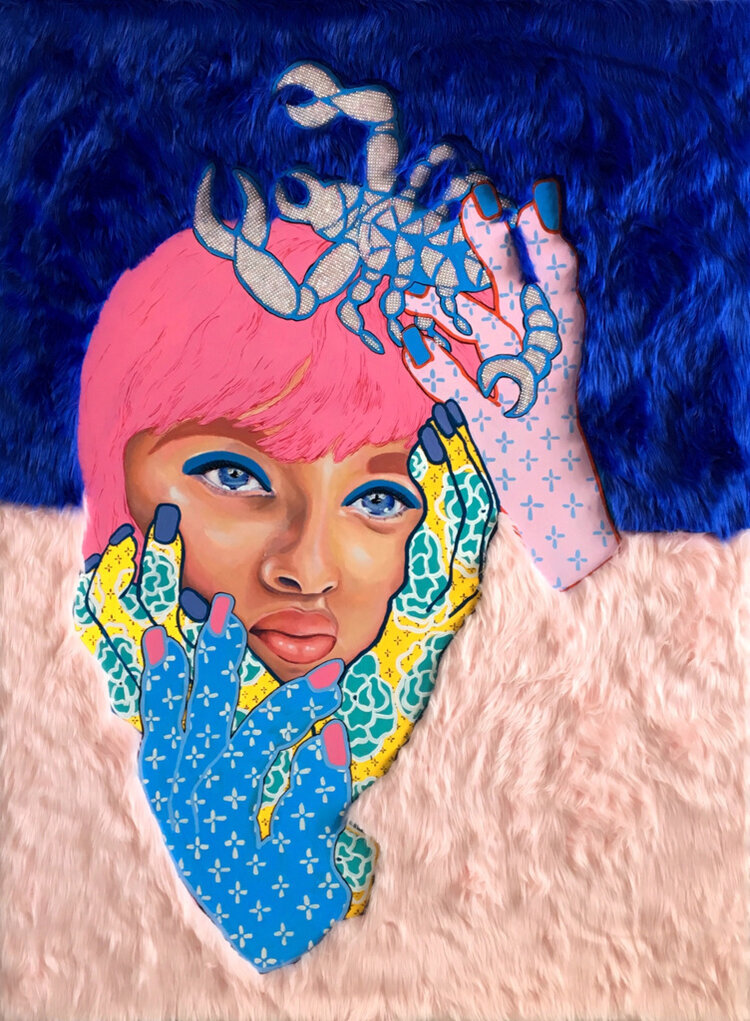“Slaysian” Takes On A New Life As An Online Exhibit
Robert Apolinar’s “Phoenix Flame” is being indefinitely displayed as part of “Slaysian.” Photo from “Slaysian.”
When Jenny Lam set out to curate “Slaysian,” she knew it could be anything. Lam, an artist herself, had already made an impression on Chicago’s art world. Her ongoing interactive project, Dreams of The City, a crowdsourced map of Chicago networked through postcards, was shown at the Chicago Cultural Center. Two shows she had previously curated, I CAN DO THAT in 2012, and LEXICON in 2016, opened to acclaim, with her work receiving coverage in NewCity and Chicago Reader.
After securing gallery space at Co Prosperity Sphere in Bridgeport, Lam started working on her next project: a show dedicated solely to spotlighting Asian American artists. “I love the Chicago art scene, but like with any art scene, it can kind of be the same names over and over again,” Lam says. “Before the show, I was thinking to myself, there's got to be Asian American artists out there. I know they're here, but I never really see that many represented in a gallery.”
Lam decided, then, that before anything, “Slaysian” would be a celebration, a show all about weaving through the world as an Asian-American, proudly. “I've always been proud of my identity and always been proud of my culture and also being from the Midwest,” Lam, whose parents immigrated from Hong Kong and eventually settled in the Chicago suburbs, says. “I've never personally seen a show like this before. I've never seen a show that was all Asian American, local, large scale. So I was like, I'm gonna do this.”
Then, the coronavirus hit, bringing the city’s social sphere to a grinding halt, and indefinitely postponing the opening of “Slaysian.” In response, Lam announced that instead of its originally planned weeklong showing, which would have opened on March 20 and closed eight days later, the show would transition into an entirely digital exhibition.
Joyce Jodie Kim’s “The Story of the Sensitives.” Photo from “Slaysian.”
She contemplated the idea of holding off on the show entirely until the city could safely resume normal operation. Lam is, after all, a believer in the idea that art is best experienced in person. But, the uptick in anti-Asian violence and rhetoric, paired with the US government’s careless usage of phrases like “the Chinese virus,” underscored why Lam created the exhibition in the first place. “When I set out to do the show, it was originally just gonna be about celebration. We're going to come and we're going to party and it will be a cool thing,” Lam says. “It's still that, but [now] there's also this other angle where it's like a fist in the air. Like, this is our way of supporting each other in this atmosphere.”
“Slaysian” emerged with a newfound weight on its shoulders. But, this was a show designed to withstand these sorts of changes. This was a show that would not only build itself on the themes that bind together the Asian-American community, but also the countless personal histories of its artists and the generations that come before them.
The 39 artists selected for “Slaysian” were found through an open call Lam had placed that set only two parameters: the artists had to be Asian-American and they had to be local. Lam played purposefully loose with the call’s “local” directive, leaving it up to the artists’ interpretation. Whether the artists took this as meaning being from Chicago, from Illinois, or from the greater Midwest, did not matter much to Lam. What was more important, she says, was creating and pulling from as wide a pool of Asian-American talent as possible.
“By the nature of the open call, it's kinda like the job was done for me. I didn't have to seek out different voices because all the voices were already there,” Lam says. “Having so many stories means that one story doesn't have to feel like it represents an entire group as a monolith.”
Tshab Her’s “Nam Hab Kuve (Mom and Me).” Photo from “Slaysian.”
When selecting the artists whose work would appear in the show, Lam, as “Slaysian’s” sole curator, says she was not looking for anything in particular. She has an eye for technical proficiency, and admits that she generally leans towards pieces that find ways to disrupt these conventions. But, for the most part, she waited for a moment of kismet, the type of reaction sparked in the viewer by the artist that is so visceral and instantaneous it could best be described as chemical.
A survey of a few works that populate the world of “Slaysian”: Tshab Her’s “Nam Hab Kuve (Mom and Me)” a colorful, striped banner quilted together with traditional Hmong fabrics as a nod to the Hmong diaspora. Rialin José’s “Magandang Araw sa Palengke (A Good Day at the Market),” a candy-bright illustration of a typical scene from wandering through a Filipino market. Yuqing Zhu’s “Tarvaa, Horsehead Fabler” which depicts the artist’s disembodied head and hands playing a morin khuur, a traditional Mongolian instrument.
And, as the way the world experiences almost everything has been entirely upended for the foreseeable future, so has the process of appreciating art. “Slaysian” can be viewed exclusively through a screen, an audience intermediary Lam does not typically account for when planning her shows. “When I create shows, I like packing a lot of people into one space at a time,“ she says. “Whereas the process of viewing art now is very isolated.“
The opening night party Lam had been planning for the show, set for March 20, the day before Illinois’ stay-at-home order set into effect, would have featured several live performances from the artists, meant to enhance the experience of viewing their work in person. “There's no replicating a physical show and just the experience of being with other people and chatting with the artists and having a spontaneous experience that way,” Lam says.
However, a silver lining has emerged from the show’s digital rebirth.The internet has long given artists a platform to exhibit their work as widely as possible, and “Slaysian” — the online experience — is no exception. Lam says the show’s new home has the capability of accessing an even greater lifespan and capacity than a physical space would have allowed.
“It's gonna be up for as long as the website is up,” she says. “And people who wouldn't normally have gone to a gallery show, or people who just physically weren’t able to travel to Chicago [can see the show]. So it definitely changes the way that you can share artwork.”
Lam is currently sharing the artists’ work one-by-one on her social media. This method of promotion, she says, brings up a whole new set of algorithmic considerations. Primarily, what type of art would look best when you have mere seconds to capture someone’s attention? What would best recreate the moment of connection that Lam felt when she herself first saw these pieces? Then, what could best serve as a balm to the seemingly constant drip of bad news that has besieged the planet?
“SORRY, MOM” by Caroline Liu. Photo from “Slaysian.”
“I don't propose that [the show] is going to change the world... but I always say that art can plant the seed,” Lam says. “Within the Asian American community, art can also be a source of comfort instead of consuming all the doom and gloom of news about racism, which can be really tiring. You can turn to art and be comforted by that and connect with people through that.”
At some point, Lam hopes to physically exhibit the show as it was originally intended. However, the untenable nature of living through a pandemic has left those plans unsteady at best. But, as Lam is learning, “Slaysian” has the ability to shapeshift and adapt to whatever it needs to be. She floats the idea of retooling the show, in its next life, to display each of the artists’ most recent work, as a nod to their individual evolutions.
“There's an unlimited amount of talent right here in Chicago within the Asian American communities,” Lam says. “The main goal is showing off talent that is local and underrepresented. And now, just being like, Asian Americans are awesome. Like, we're great. I like that celebration, being proud of who we are and our identity and having self love and love for our community.”





